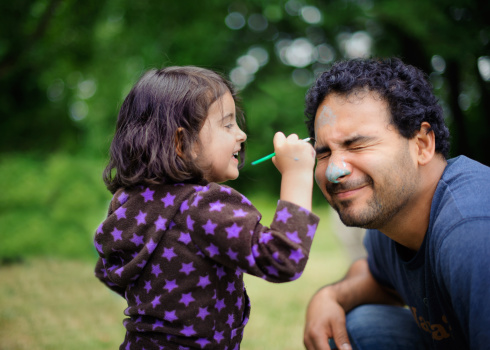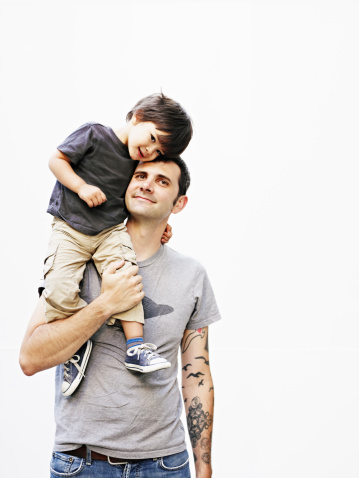
In my meetings with kids, I ask them to share perspectives on family, including hopes and wishes for how family might work best when parents are living in separate homes. I recently had the privilege to meet with four amazing young women; siblings whose parents are getting unmarried in a
Collaborative Team Process.
I continually learn from kids with whom I work as a neutral child specialist. Each of these girls made thoughtful observations for me to share with their parents, so I asked them and their parents if I could write a blog post to share these ideas with others. Because they are thoughtful, empathetic and generous people, they agreed, and have my deep gratitude and appreciation.
Below are words of wisdom from Lauren, Kelly, Emily and Grace. Though focusing on one quote per girl, I want to stress that each of them had many wonderful insights about all the areas mentioned.
Lauren on Holiday and Birthday Celebrations
“I want one graduation party, not two. This is about me, not my parents. And I want them both to come and to get along.”
Lauren’s words represent the viewpoint of many kids, and are a powerful reminder that children of all ages have strong feelings about family celebrations. Lauren also talked about preserving family traditions on both sides for holidays, like Christmas. Tuning in to kids’ perspectives can help parents figure out how to preserve important traditions while adding new ones, providing grounding and clarity for all family members.
Kelly on Co-parent Cooperation
“I want my parents to remember they’re both always my parents no matter which house I am at.”
Kelly’s words articulate the heart of the positive and profound shift in family law away from attaching custody labels toward co-parenting and creating parenting plans based on the best interests of kids. Kids dislike the feeling of going from “Mom Island” to “Dad Island,” and feel safer if parents respect and honor their relationships with both parents. Effective co-parent communication is a centerpiece of parenting and relationship plans in Collaborative Team Practice.
Emily on Transitions between Homes
“I hope my parents will have a one to two hour window for me to go from one house to the other, so it’s do-able if I am in the middle of something or with a friend.”
One of the most challenging aspects of a divorce for kids is transitioning between homes. It is vital that parents work together to make transitions as smooth, cordial and stress-free as possible. Emily’s words are an important reminder to regularly check in and listen to kids about what is working well and not so well in transitions. Parents need patience and empathy: kids have lives too!
Grace on Family Transformation
“I want us to be a together and apart family. We’re still a family, but we’re just split.”
Grace absolutely nailed why I do the work I do as a neutral child specialist. What she said is both insightful and core to helping kids develop resilience. It is so important that all family members move forward with the deep understanding that getting unmarried does not end a family with children, but transforms it.
Thank you Lauren, Kelly, Emily and Grace. We will keep listening!
 A core value of Collaborative Team Practice is keeping children at the center and out of the middle. But what does this mean? Why this is distinction important? It is because divorcing parents are writing the life story their children will tell.
Mindfully keeping children at the center helps focus decision-making during and after a divorce on the best interests of the children. It encourages parents and the professionals assisting them to consider children’s developmental needs and temperaments to create customized parenting time schedules, relationship plans and financial plans. Bringing children’s voices into the process means the perspectives of all family members are honored. Parents who keep children at the center are doing the important work of becoming effective co-parents and communicators. Their children do not experience parents arguing or criticizing each other. They do not have to worry about taking sides or being disloyal to one parent by continuing to love the other. Children at the center are given empathy, support and patience as they grieve the loss of their familiar family structure, but are also reminded that though parents are unmarried, the family is still a family. Children at the center can have hope for the future, with rewarding relationships with both parents strengthening their resilience.
What is the experience of children in the middle? Unfortunately, these children are regularly exposed to their parents’ active conflict. They may frequently hear parents badmouthing each other or calling each other names. Children in the middle have often been told adult-level details about their parents’ marriage and their divorce. They may be actively encouraged by one or both parents to blame or take sides against the other parent. Parents who are not focusing on their children’s needs may be more likely to become emotionally disconnected from them or even to move away. Children in the middle are children in distress.
Children at the center are given support to feel emotionally safe. They do not have to grow up with the anxiety of worrying about whether both parents can be invited to the same life event without creating undue stress and conflict. In contrast, children in the middle often experience the crisis of a divorce as a trauma, and the negative impact reverberates throughout their lives. Children in the middle have a much more difficult time with trust and fear of abandonment as adults.
Collaborative Team Practice offers potential sources of emotional support to all family members during and after a divorce. Neutral child specialists offer a child-inclusive process to help parents create and implement developmentally responsive parenting plans. Neutral coaches help parents create a relational plan to support their co-parenting and manage current and future conflicts. Both the parenting plan and the relationship plan are designed to keep children at the center, and have their life stories about the divorce end peacefully.
A core value of Collaborative Team Practice is keeping children at the center and out of the middle. But what does this mean? Why this is distinction important? It is because divorcing parents are writing the life story their children will tell.
Mindfully keeping children at the center helps focus decision-making during and after a divorce on the best interests of the children. It encourages parents and the professionals assisting them to consider children’s developmental needs and temperaments to create customized parenting time schedules, relationship plans and financial plans. Bringing children’s voices into the process means the perspectives of all family members are honored. Parents who keep children at the center are doing the important work of becoming effective co-parents and communicators. Their children do not experience parents arguing or criticizing each other. They do not have to worry about taking sides or being disloyal to one parent by continuing to love the other. Children at the center are given empathy, support and patience as they grieve the loss of their familiar family structure, but are also reminded that though parents are unmarried, the family is still a family. Children at the center can have hope for the future, with rewarding relationships with both parents strengthening their resilience.
What is the experience of children in the middle? Unfortunately, these children are regularly exposed to their parents’ active conflict. They may frequently hear parents badmouthing each other or calling each other names. Children in the middle have often been told adult-level details about their parents’ marriage and their divorce. They may be actively encouraged by one or both parents to blame or take sides against the other parent. Parents who are not focusing on their children’s needs may be more likely to become emotionally disconnected from them or even to move away. Children in the middle are children in distress.
Children at the center are given support to feel emotionally safe. They do not have to grow up with the anxiety of worrying about whether both parents can be invited to the same life event without creating undue stress and conflict. In contrast, children in the middle often experience the crisis of a divorce as a trauma, and the negative impact reverberates throughout their lives. Children in the middle have a much more difficult time with trust and fear of abandonment as adults.
Collaborative Team Practice offers potential sources of emotional support to all family members during and after a divorce. Neutral child specialists offer a child-inclusive process to help parents create and implement developmentally responsive parenting plans. Neutral coaches help parents create a relational plan to support their co-parenting and manage current and future conflicts. Both the parenting plan and the relationship plan are designed to keep children at the center, and have their life stories about the divorce end peacefully.  A core value of Collaborative Team Practice is keeping children at the center and out of the middle. But what does this mean? Why this is distinction important? It is because divorcing parents are writing the life story their children will tell.
Mindfully keeping children at the center helps focus decision-making during and after a divorce on the best interests of the children. It encourages parents and the professionals assisting them to consider children’s developmental needs and temperaments to create customized parenting time schedules, relationship plans and financial plans. Bringing children’s voices into the process means the perspectives of all family members are honored. Parents who keep children at the center are doing the important work of becoming effective co-parents and communicators. Their children do not experience parents arguing or criticizing each other. They do not have to worry about taking sides or being disloyal to one parent by continuing to love the other. Children at the center are given empathy, support and patience as they grieve the loss of their familiar family structure, but are also reminded that though parents are unmarried, the family is still a family. Children at the center can have hope for the future, with rewarding relationships with both parents strengthening their resilience.
What is the experience of children in the middle? Unfortunately, these children are regularly exposed to their parents’ active conflict. They may frequently hear parents badmouthing each other or calling each other names. Children in the middle have often been told adult-level details about their parents’ marriage and their divorce. They may be actively encouraged by one or both parents to blame or take sides against the other parent. Parents who are not focusing on their children’s needs may be more likely to become emotionally disconnected from them or even to move away. Children in the middle are children in distress.
Children at the center are given support to feel emotionally safe. They do not have to grow up with the anxiety of worrying about whether both parents can be invited to the same life event without creating undue stress and conflict. In contrast, children in the middle often experience the crisis of a divorce as a trauma, and the negative impact reverberates throughout their lives. Children in the middle have a much more difficult time with trust and fear of abandonment as adults.
Collaborative Team Practice offers potential sources of emotional support to all family members during and after a divorce. Neutral child specialists offer a child-inclusive process to help parents create and implement developmentally responsive parenting plans. Neutral coaches help parents create a relational plan to support their co-parenting and manage current and future conflicts. Both the parenting plan and the relationship plan are designed to keep children at the center, and have their life stories about the divorce end peacefully.
A core value of Collaborative Team Practice is keeping children at the center and out of the middle. But what does this mean? Why this is distinction important? It is because divorcing parents are writing the life story their children will tell.
Mindfully keeping children at the center helps focus decision-making during and after a divorce on the best interests of the children. It encourages parents and the professionals assisting them to consider children’s developmental needs and temperaments to create customized parenting time schedules, relationship plans and financial plans. Bringing children’s voices into the process means the perspectives of all family members are honored. Parents who keep children at the center are doing the important work of becoming effective co-parents and communicators. Their children do not experience parents arguing or criticizing each other. They do not have to worry about taking sides or being disloyal to one parent by continuing to love the other. Children at the center are given empathy, support and patience as they grieve the loss of their familiar family structure, but are also reminded that though parents are unmarried, the family is still a family. Children at the center can have hope for the future, with rewarding relationships with both parents strengthening their resilience.
What is the experience of children in the middle? Unfortunately, these children are regularly exposed to their parents’ active conflict. They may frequently hear parents badmouthing each other or calling each other names. Children in the middle have often been told adult-level details about their parents’ marriage and their divorce. They may be actively encouraged by one or both parents to blame or take sides against the other parent. Parents who are not focusing on their children’s needs may be more likely to become emotionally disconnected from them or even to move away. Children in the middle are children in distress.
Children at the center are given support to feel emotionally safe. They do not have to grow up with the anxiety of worrying about whether both parents can be invited to the same life event without creating undue stress and conflict. In contrast, children in the middle often experience the crisis of a divorce as a trauma, and the negative impact reverberates throughout their lives. Children in the middle have a much more difficult time with trust and fear of abandonment as adults.
Collaborative Team Practice offers potential sources of emotional support to all family members during and after a divorce. Neutral child specialists offer a child-inclusive process to help parents create and implement developmentally responsive parenting plans. Neutral coaches help parents create a relational plan to support their co-parenting and manage current and future conflicts. Both the parenting plan and the relationship plan are designed to keep children at the center, and have their life stories about the divorce end peacefully. 

 The longer I work as a
The longer I work as a 
 Divorce is a crisis in the life of a family. It is not actually a legal crisis, though it requires this expertise to ensure that legal resolutions are reached regarding financial matters. It is not a theoretical crisis. It is a genuine emotional crisis. What does this mean for children?
Some years after I began my therapy practice with children and families decades ago, a researcher named Judith Wallerstein published the results of her longitudinal study on the negative impact of divorce on children. The data were a wake-up call, shocking to some, sobering to all. Mental health experts responded by saying parents and social institutions needed to be more attentive to the impact of divorce on children. A book was written advocating bird nesting—parents rather than children transitioning to and from the homestead—as an alternative “custody” arrangement for families (an option we now know to be a temporary rather than permanent solution). Questions began to be raised on the impact of parenting time arrangements that essentially minimized otherwise healthy and loving relationships between parents and children.
At the time Wallerstein’s study was published, the options available for divorcing parents were largely adversarial in nature. The focus was “rights based,” not based on supporting co-parenting and keeping children out of the middle of the crisis. Many of the parents with whom I work attest to the emotional trauma they experienced when their own parents divorced. In fact, it is likely these divorcing parents were assured by their attorneys that “children are resilient—your kids will be fine.” But we know that children do not become resilient in a vacuum. They need adults to create environments of support and attention to their needs.
Collaborative team divorce offers a clear and powerful alternative for parents who love their children and want to envision a hopeful future for them. Families work with a multidisciplinary team of professionals with specific skills and experience. Mental health expertise is woven throughout the process, both to specifically support children and to provide parents with the best possible grounding for effective co-parenting. If you want to know more about how your family can weather the emotional crisis of divorce with the most dignity and respect for the needs of your children, please learn more about Collaborative team practice at this link to the website for the
Divorce is a crisis in the life of a family. It is not actually a legal crisis, though it requires this expertise to ensure that legal resolutions are reached regarding financial matters. It is not a theoretical crisis. It is a genuine emotional crisis. What does this mean for children?
Some years after I began my therapy practice with children and families decades ago, a researcher named Judith Wallerstein published the results of her longitudinal study on the negative impact of divorce on children. The data were a wake-up call, shocking to some, sobering to all. Mental health experts responded by saying parents and social institutions needed to be more attentive to the impact of divorce on children. A book was written advocating bird nesting—parents rather than children transitioning to and from the homestead—as an alternative “custody” arrangement for families (an option we now know to be a temporary rather than permanent solution). Questions began to be raised on the impact of parenting time arrangements that essentially minimized otherwise healthy and loving relationships between parents and children.
At the time Wallerstein’s study was published, the options available for divorcing parents were largely adversarial in nature. The focus was “rights based,” not based on supporting co-parenting and keeping children out of the middle of the crisis. Many of the parents with whom I work attest to the emotional trauma they experienced when their own parents divorced. In fact, it is likely these divorcing parents were assured by their attorneys that “children are resilient—your kids will be fine.” But we know that children do not become resilient in a vacuum. They need adults to create environments of support and attention to their needs.
Collaborative team divorce offers a clear and powerful alternative for parents who love their children and want to envision a hopeful future for them. Families work with a multidisciplinary team of professionals with specific skills and experience. Mental health expertise is woven throughout the process, both to specifically support children and to provide parents with the best possible grounding for effective co-parenting. If you want to know more about how your family can weather the emotional crisis of divorce with the most dignity and respect for the needs of your children, please learn more about Collaborative team practice at this link to the website for the 


